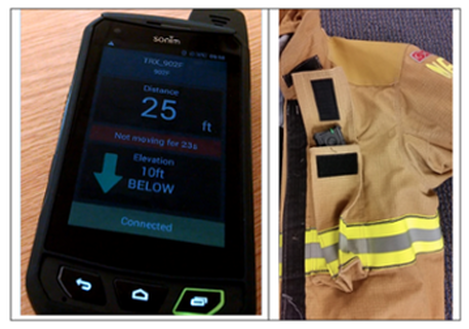|
Fire Departments in rural/small suburban areas identified a gap for the development of a hardware and software system that helps firefighting Incident Commanders and Team Leaders to maintain team integrity within the fire ground. Supported by the Department of Homeland Security First Responder group, we developed an affordable high accuracy time of flight ranging solution in an effort to fill this operational gap. The aim of the system is to provide team leads and search parties with very accurate ranging information to their team. The access to the ranging information will help to reduce the time to find a firefighter in distress in low visibility conditions. This low cost tool can help rural or small fire departments keep track of their firefighters inside burning buildings. The images below show the prototype Android App and the small proximity device developed by the TRX team.
The ranging solution is based on the latest ultra-wideband time of flight ranging sensors. Ultra-wideband sensors use a frequency bandwidth of 500Mz or more. The wide bandwidth significantly reduces multipath errors - that is, errors in the ranging measurements caused by signals bouncing off walls and other objects in the cluttered indoor environments. The solution provides sub-meter ranging accuracy over distances up to approximately 50 meters. The operational range of the solution is currently limited by FCC requirements on the power of signal emission for ultra-wideband signal sources. The 50 meter range is more than adequate for maintaining the integrity of teams operating together. Another benefit of the ultra-wideband system is that the sub-meter level ranging accuracy is able to be maintained even when passing through standard office walls. While the sensors are a huge improvement over signal strength based ranging in terms of their accuracy, they do not defeat the laws of physics so the ranging measurements will still be blocked by some building materials such as metals. In addition to the ranging, the TRX Systems proximity device includes other sensors that enable us to provide relative elevation information; allowing a search team to know that a firefighter is 25 feet away and 10 feet below. This information would allow a RIT team, for example, to measure range and relative elevation from outside of a building. In February the system was tested with Herman VFC Fire Chief Rob McLafferty (one of the subject matter experts advising DHS and TRX Systems on this development program) and several firefighters from the Herman VFC . The test was designed to give the firefighters a feel for how the system would work in the best conditions (line of sight) and also how the system would work during team operations and searches in areas of different construction. The Proximity Sensor will ultimately be integrated with self-contained breathing apparatus (SCBA). During this program we worked with MSA to develop an ICD sharing the proximity information for display on their SCBA interface. MSA will be demonstrating the ranging capability integrated directly into their G1 SCBA at FDIC (Booth 2111). We will be delivering 100 proximity units to the Department of Homeland Security for further testing with rural and small suburban departments. For more information on the Firefighter Accountability and Proximity System, read the article by the Department of Homeland Security. Comments are closed.
|
AuthorWrite something about yourself. No need to be fancy, just an overview. Archives
June 2024
Categories |
Company |
|


 RSS Feed
RSS Feed



